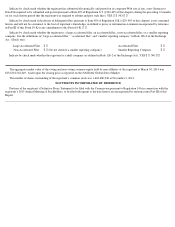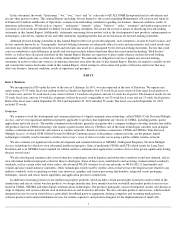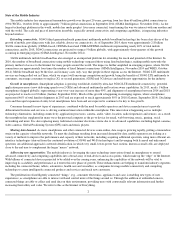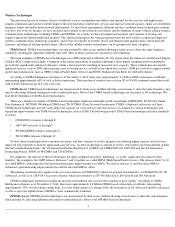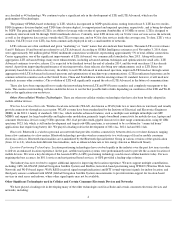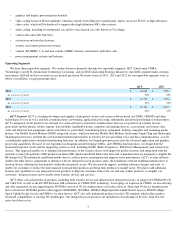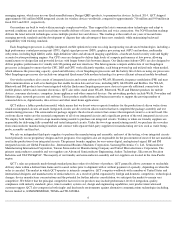Qualcomm 2014 Annual Report Download - page 13
Download and view the complete annual report
Please find page 13 of the 2014 Qualcomm annual report below. You can navigate through the pages in the report by either clicking on the pages listed below, or by using the keyword search tool below to find specific information within the annual report.
extensively licensed portfolio in the industry with over 260 licensees. Additionally, we have a substantial patent portfolio related to key
technologies used in communications and other devices and/or related services, some of which were developed in industry standards
development bodies. These include H.264 video codec technology, the next generation video codec technology (H.265 or high-efficiency video
codec), advanced WLAN (802.11ac), volatile (LP-DDR2, 3, 4) and non-volatile (eMMC) memory controllers, operating systems, user
interfaces, graphics and camera processing, packaging techniques, sensor and sensor fusion algorithms and application processor architectures.
We recently added to our patent portfolio by acquiring patents related to mobile device operating systems (and other/related technologies) from
Hewlett Packard, formerly patents of Palm, an early smartphone and personal operating system pioneer. Over the years, a number of companies
have challenged our patent position, but at this time, companies in the mobile communications industry generally recognize that any company
seeking to develop, manufacture and/or sell subscriber units or infrastructure equipment that use CDMA and/or OFDMA technologies will
require a license or other rights to use our patents.
We have licensed or otherwise provided rights to use our patents to hundreds of companies on industry-accepted terms. Unlike some other
companies in our industry that hold back certain key technologies, we offer companies substantially our entire patent portfolio for use in cellular
subscriber devices and cell site infrastructure equipment. Our strategy to make our patented technologies broadly available has been a catalyst
for industry growth, helping to enable a wide range of companies offering a broad array of wireless products and features while increasing the
capabilities of and/or driving down average and low-end selling prices for 3G handsets and other wireless devices. By licensing or otherwise
providing rights to use our patents to a wide range of equipment manufacturers, encouraging innovative applications, supporting equipment
manufacturers with integrated chipset and software products and focusing on improving the efficiency of the airlink for wireless operators, we
have helped 3G CDMA evolve and grow, and reduced device pricing, all at a faster pace than the 2G technologies that preceded it (e.g., GSM).
Standards bodies have been informed that we hold patents that might be essential for all 3G standards that are based on CDMA. We have
committed to such standards bodies that we will offer to license our essential patents for these CDMA standards on a fair, reasonable and non-
discriminatory basis. We have also informed standards bodies that we hold patents that might be essential for certain standards that are based on
OFDMA technology (e.g., 802.16e, 802.16m and LTE (including FDD and TDD versions)) and have committed to offer to license our essential
patents for these OFDMA standards on a fair, reasonable and non-discriminatory basis. We have made similar commitments with respect to
certain other technologies implemented in industry standards.
Our license agreements generally provide us rights to use certain of our licensees’ technology and intellectual property to manufacture and
sell certain components (e.g., Application-Specific Integrated Circuits) and related software, subscriber units and/or infrastructure equipment. In
most cases, our use of our licensees’ technology and intellectual property does not require us to pay royalties based on the sale of our products.
However, under some of the licenses, if we incorporate certain of our licensees’ licensed technology or intellectual property into certain of our
products, we are obligated to pay royalties on the sale of such products.
QSI Segment. QSI makes strategic investments that are focused on opening new or expanding opportunities for our technologies and
supporting the design and introduction of new products and services (or enhancing existing products or services) for voice and data
communications. Many of these strategic investments are in early-stage companies in a variety of industries, including, but not limited to, digital
media, e-commerce, energy, healthcare and wearable devices. Investments primarily include non-
marketable equity instruments, which generally
are recorded using the cost method or the equity method, and convertible debt instruments, which are recorded at fair value. QSI also holds
wireless spectrum, which at September 28, 2014, consisted of L-Band spectrum in the United Kingdom. As part of our strategic investment
activities, we intend to pursue various exit strategies for each of our QSI investments in the foreseeable future.
Other Businesses. During the first quarter of fiscal 2014, we reassessed our management reporting as a result of the sale of the North and
Latin America operations of our Omnitracs division, among other reasons. The Omnitracs division was previously aggregated with three other
divisions into the Qualcomm Wireless & Internet (QWI) reportable segment. Starting in fiscal 2014, the QWI segment was eliminated, and the
former QWI divisions are included in nonreportable segments.
Nonreportable segments include our QMT (Qualcomm MEMS Technologies), Pixtronix and Small Cells divisions and other wireless
technology and service initiatives. QMT plans to license its next generation IMOD (interferometric modulator) display technology and to focus
on wearable devices. Pixtronix develops and licenses display technologies based on MEMS (micro-electro-mechanical-systems) structure
optimized for portable multimedia devices. Small Cells develops and supplies 3G/LTE and Wi-
Fi products designed for implementation of small
mobile base stations (known as small cells). Other nonreportable segments develop and offer products and services that include, but are not
limited to: software products and content and push-to-talk enablement services to wireless operators; development, other services and related
products to U.S. government agencies and their contractors; device-to-device communication, including software for the connected home; data
center products; medical device connectivity and related data management; and augmented reality.
8


